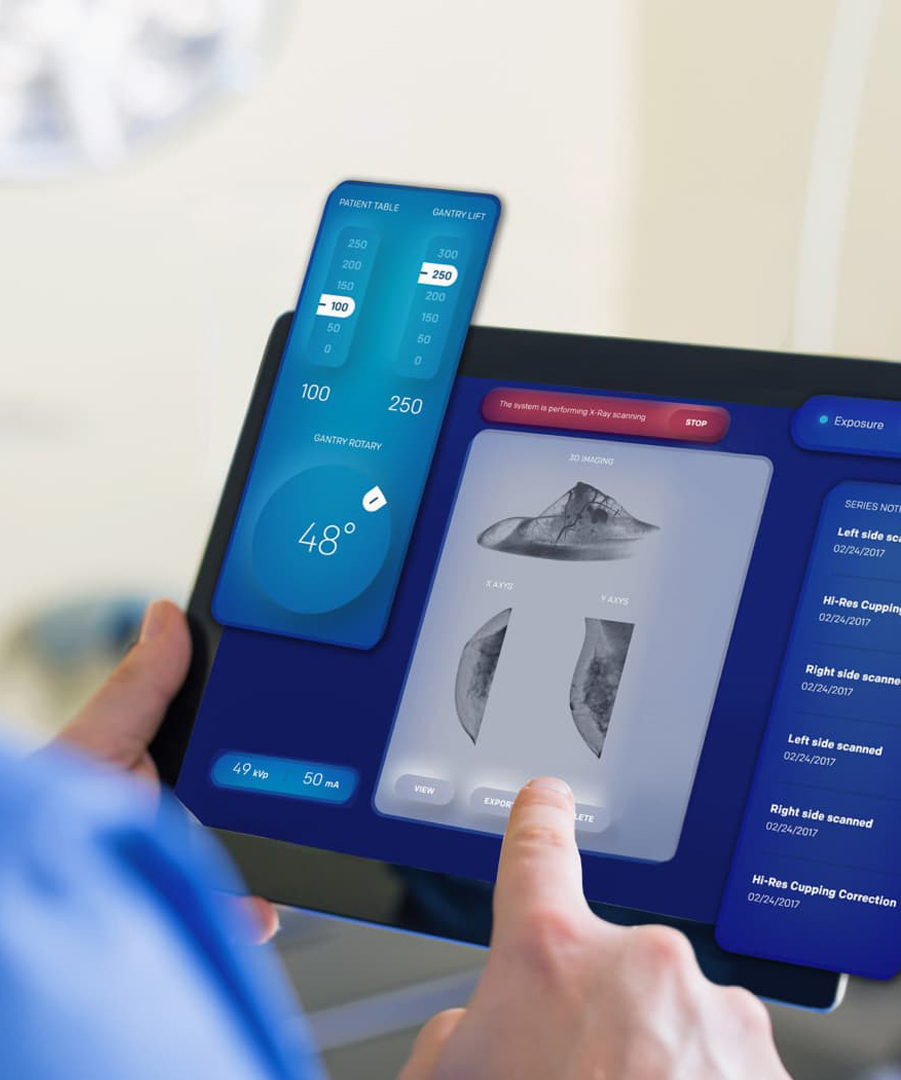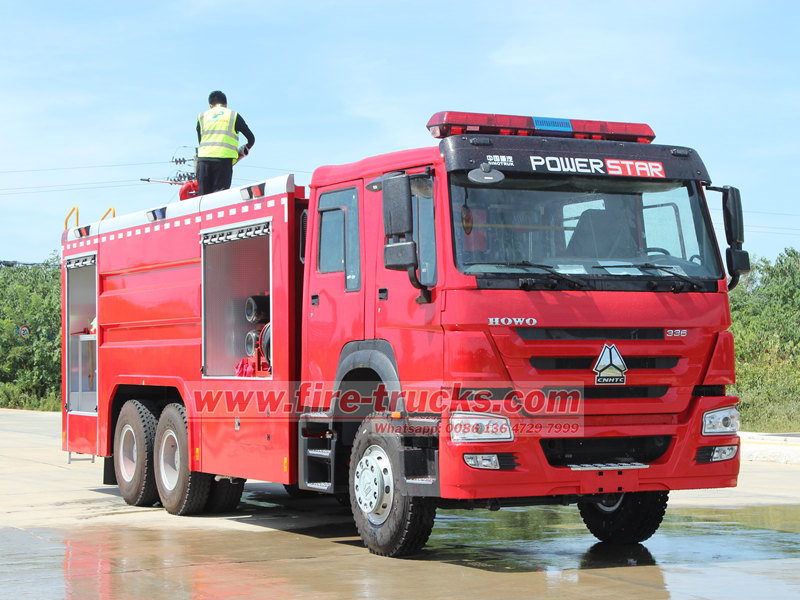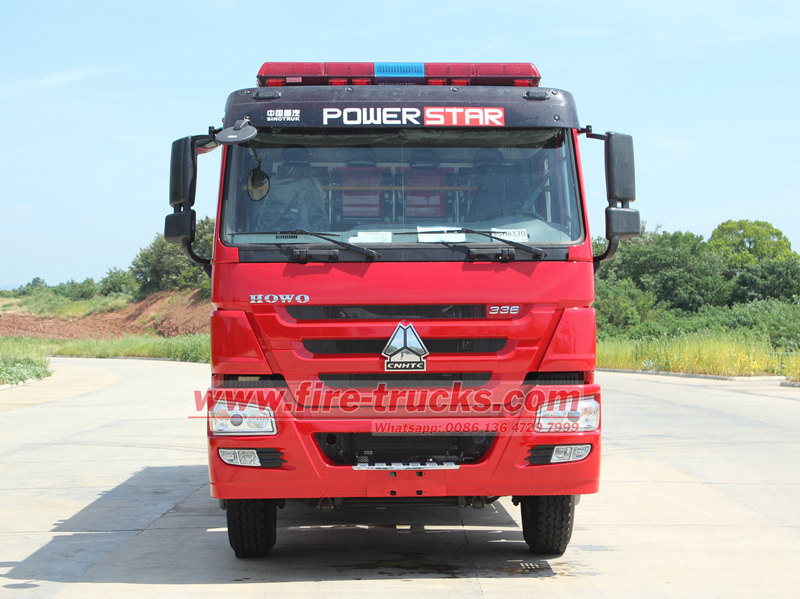


消防車 火災や緊急救助活動に対応する中核設備であり、その性能と信頼性は消火効率と人員の安全に直接影響を及ぼします。中国の商用車部門のリーディングブランドであるHOWOは、泡消火車の優れた出力、安定性、そして専門的な設計により、石油化学工場、空港、工業団地などの高リスク環境で広く採用されています。本稿では、泡消火車の構造設計を体系的に分析します。 HOWO泡消防車 ユーザーが技術的な特徴や機能上の利点を深く理解できるようにします。

1. HOWO泡消火車の概要
HOWO泡消防車は、HOWO専用シャーシをベースに改造され、水タンク、泡タンク、消火ポンプ、インテリジェントプロポーショニングシステム、配管、そして消火設備を統合しています。水と泡の両方の消火能力を備えています。国家消防設備基準に準拠して設計されたこれらの車両は、石油や化学火災などの可燃性液体火災の消火に特に適しているだけでなく、一般的な固形物火災救助活動のニーズにも応えます。
2. HOWO泡消火車の主な構造
HOWO泡消防車は、シャーシと上部構造の2つの主要部分で構成されています。シャーシは車両の駆動力を担い、上部構造は消火機能を担います。
(1)シャーシ
HOWOシャーシは、優れたパワー、安定性、そして信頼性で高く評価されています。消防車には通常、高出力ディーゼルエンジンを搭載したHOWOシャーシが採用されており、緊急時の迅速な出動要件を満たしています。さらに、HOWOシャーシは優れたオフロード性能を備えており、様々な複雑な道路状況下でも消防車が迅速に現場に到着することを可能にします。

(2)上部構造
上部構造はHOWO泡消火車両の中心となる部分で、主に水タンク、泡タンク、消火ポンプ、泡噴射システム、配管システム、各種消防設備で構成されています。
• 水タンクと泡タンク
水タンクと泡タンクは、消火薬剤を貯蔵する上で重要な部品です。水タンクは通常、消防車の後部に配置され、高強度鋼板で作られており、実際のニーズに合わせて容量をカスタマイズできます。泡タンクは水タンクの前または上に配置され、泡原液を貯蔵するために高強度材料で作られています。両方のタンクにはレベルゲージと排水口が装備されており、オペレーターは媒体レベルを監視し、メンテナンスを容易に行うことができます。
• 消防ポンプ
消防ポンプは、
HOWO 泡消火剤消防車
水や泡原液を加圧し、消火監視装置や消火ホースに送液する役割を担っています。このポンプは一般的に遠心式または往復式の構造を採用しており、高流量、高圧、安定した性能を特徴としています。様々な消火ニーズに対応するため、この消火ポンプは複数のギア変速オプションを備えており、流量と圧力出力を調整できます。

• 泡配合システム
泡消火システム(Foam Quantum System)は、泡消火能力を実現する重要な構成要素です。水と泡原液の比率を正確に制御することで、最適な消火効果を確保します。このシステムでは通常、精度、簡便性、信頼性で知られるベンチュリー管式または機械式プロポーショナーが採用されています。
• 配管システム
配管システムは、消防ポンプ、水タンク、泡タンク、消防設備を接続し、水と泡原液を火災現場へ輸送します。高強度鋼管またはホースで作られており、優れた耐圧性と耐腐食性を備えています。また、各種バルブや継手も備えており、オペレーターは必要に応じて接続・切り替えが可能です。
• 消防設備
消火設備は、モニターや消火ホースなど、火災を直接消火するためのツールです。モニターは通常、消防車の屋根または後部に取り付けられており、長距離かつ大量の消火が可能で、大規模火災に適しています。消火ホースは消防車の側面または後部に配置されており、柔軟に配置できるため、オペレーターはさまざまな位置から消火活動を行うことができます。

3. HOWO泡タンク消防車の性能上の利点
(1)高効率:
HOWO 泡消防車は、高度な泡噴射システムと消火設備を備えており、さまざまな種類の火災、特に油火災などの可燃性液体火災を迅速かつ効果的に消火できます。
(2)安定性と信頼性:
HOWO シャーシは、優れたパワーと安定性で堅牢なサポートを提供し、高強度材料と高度な製造技術で作られた上部構造により、過酷な環境でも信頼性の高い動作を保証します。
(3)ユーザーフレンドリーな操作:
操作システムは直感的に操作できるよう設計されており、オペレーターはすぐに機能に慣れることができます。さらに、このトラックには高度な運転支援装置と消火支援装置が搭載されており、効率性を高めています。
(4) メンテナンスが簡単:
各コンポーネントには、アクセスしやすいメンテナンスポートと点検スペースが設けられており、日常的なメンテナンスを簡素化します。また、包括的な故障診断システムと警報装置を備えており、問題を迅速に検知して対処します。
4. HOWO泡消火車両の適用シナリオ
HOWO 泡消防車は、その高い効率性、信頼性、操作性、メンテナンスの容易さにより、以下を含むさまざまな分野で広く使用されています。
(1)化学工場:
これらの施設には大量の可燃性物質や爆発性物質が存在するため、消火活動は極めて重要です。泡消火車は迅速に火災を鎮圧し、人命と財産を守ることができます。
(2)石油貯蔵所:
石油貯蔵所は大量の可燃性液体を貯蔵する施設であるため、厳格な火災安全対策が求められます。泡消防車は石油火災に特化した消火能力を備え、安全を確保します。
(3)空港:
空港は交通量の多い交通ハブであるため、最高レベルの火災安全性が求められます。泡消火車は迅速な対応と効果的な消火を可能にし、業務の継続性と乗客の安全を確保します。
泡消防車は、高効率、安定性、信頼性に優れた消防設備として、様々な分野で重要な役割を果たしています。その構造を詳細に分析することで、その性能特性や利点についてより深い理解が得られます。将来的には、
HOWO泡消火ユニット消防車
彼らの不可欠な貢献により、生命と財産を守り続けます。

次の情報に興味があるかもしれません